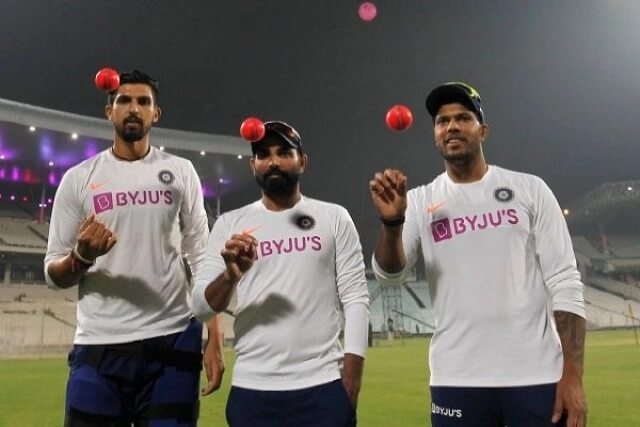India played its first-day night test match in Kolkata from November 22-24, 2019. India won their first pink ball test match which was also their first day night test match. Their second day-night test match was against Australia in Adelaide from December 17-21, 2020.
India’s national sport might be hockey, but the world knows India’s craze for cricket. In a country where every kid has played cricket in their narrow ‘Gullys’, some dreamt of becoming an international level cricketer, but only a few made their place in the Indian cricket team. The Indian cricket team showed their excellence in ODI, test matches, 20-20, and premier leagues. But it was only for day-night test matches that they took their sweet little time to say yes.
What is a day-night test match?
In October 2012, the international cricket council permitted the day-night test matches considering the playing condition. Australia hosted the first-day night test cricket match against New Zealand in November 2015, and they won the match by three wickets. Day-night matches are also popular as floodlight matches, as they play the match under floodlight. Instead of starting in the morning the match begins in the afternoon and continues till evening.
Generally, we play the test matches with the red or white ball. The visibility of the red ball under floodlight is relatively low. It was tough for the cameraman to track the ball during the second half of the match. Hence, they came up with the idea of a pink ball to play with, and that is why the day-night test match is also popular as the pink ball test.
BCCI’s approval on pink ball test
During the 2016-17 sessions, BCCI declared they will not hold any day-night test matches in that session. India played its first test match in 2019 against Bangladesh in Eden Gardens, Kolkata. Even though this was the first time India was playing a day-night test match, it was not the first time they were playing with a pink ball.
Before this, in 2016, India used the pink ball to play the Duleep Trophy. On the finals of the CAB super league, played between Bhowanipore club and Mohan Bagan, they used a pink ball to play with. The feedback from the players was very positive. They said it was easy to see the pink ball under the floodlights, where was it was not easy the catch a pink ball in daylight.
Why the pink ball?
Before the international cricket council approved the day-night test matches and the pink ball they will be playing with, there were several tests run on the orange, yellow and pink ball.
They even thought of playing with an improved white ball that will sustain up to 80 over with players wearing coloured jerseys. Three ruling brands supply the balls for international cricket matches – kookaburra, dukes, and SG. India used the Sanspareil Greenlands, commonly known as SG ball, where England uses the duke balls (England made).
Red vs Pink ball
The Core
The key difference between red and pink ball is leather. The core of the ball remains the same for both balls they make with cork and cots wool. But the leather of the pink ball is preferable, when played under artificial lighting or floodlight.
Outer Coating
Another difference between the red and the pink ball is the outer coating. The red ball has a coat of wax, which gives the red ball its shine and colour. But you cannot use wax on the pink ball as it will turn the pink ball black. So the company uses a PU based coating on the ball or commonly known as lacquer, which gives the ball its shine.
Durability of Coating
After 40-45 over the wax on the red ball fades away, as the leather absorbs it. After that, the bowler can reverse swing the ball and maintains its grip by rubbing and cleaning one side of it. But the pink ball maintains its shape even after 45 over swiftly. So there is a huge advantage for the bowlers with the pink ball.
The Stitching
Unlike kookaburra, SG ball’s seams are hand-stitched. But it is the same for both the balls. Kookaburra only stitches the two innermost stitches with hand, and they stitch the rest two stitches with the help of a machine. Because of that, the ball loses its share very quickly (within 20-25 over). But India uses the SG balls, where they stitch all four stitches with hand. The only difference is that they use a white thread to stitch the red ball and a black thread to stitch the pink ball.
The Seam
The seam of the pink ball is more pronounced. It helps the pink ball to sustain its shape for a longer time, and you can expect more swing from this ball. Even after 10-15 over the ball does not loses its PU coating. So the remains like new even after the first 20 over. Hence, the ball is easy to swing. But the red ball loses its newness easily, and the wax comes off easily. So after the first 10-15 over the wax on the ball gets absorbed.
Size and Shape
The size and shape of the pink ball are the same as the red ball. It follows the rules as per the international cricket council. The weight of the ball has to be between 156 to 162 grams. With a slight variation in weight that might even be by a gram, they will reject the ball. During a match the umpire has two gauges one is ‘go gauge’, and another is ‘no gauge.’ The circumference of ‘go gauge’ is 73 mm, and for ‘no gauge’ the circumference is 71 mm. The balls should pass through the ‘go gauge’ easily and retain on ‘no gauge.’ Hence, SG makes their balls specifically of 72 mm circumference.
Performance
The pink or red both have the same core material, but the white balls have a bouncier core. Hence, a white ball might seem lighter in weight, but its weight is the same as any other red or pink ball. We use the white ball in a few over game such as 20-20. For such games, the audience wants to see more sixes and fours, that is why they make the ball with bouncier material.
The brief history of pink ball test
The Aussies are the pioneers of the day-night test matches and pink ball test. They played their first-ever pink ball test in 2015 in Adelaide. Till now they played 8 pink ball test matches, and they are unbeatable. But they played a total of eleven-day night test matches, and so far they have been the most successful one in the pink ball tests.
India’s first pink ball test
India played their first-day night test match with a pink ball against Bangladesh in Eden Gardens, Kolkata. The BCCI chairman Sourav Ganguly said the city turned pink with pink decorations and light because of this pink ball test. There was more hype for the pink ball than the rivalry between India and Bangladesh. However, it was the second test match out of four test matches, and India won it.
After this last year, India played their second pink ball test match against Australia, which they lost.
With passing time, international cricket is evolving. The barriers to playing are adverse circumstances getting negligible day by day. We are coming up with new ideas to cope up with different situations. A few decades ago, the face of cricket was different than it is now. Back then they never thought of playing cricket at night, especially test cricket where the jerseys are white. But, this pink ball made day-night test matches possible. In the coming days we are looking forward to many more advancements and up gradation in this game of cricket.
FAQ
What is the pink ball test?
The pink ball test is the test match played with a pink ball instead of the traditionally used red ball. They use it specifically on the day-night test matches where they start the match by the afternoon that went on till evening. The pink has such designs and features that the ball provides better visibility in floodlight.
How many pink ball tests played?
Total fifteen day-night test match or pink ball tests have been played. Among which Australia won all eight pink ball tests that they played. India played two pink ball tests, and they won one of them.
When is the next pink ball test/day-night test match?
The next pink ball test or day-night test match is on February 24, 2021, where India will host England. This will be the thirds test match of the season in which they will play in the newly built stadium Motera cricket stadium.
When was the first pink ball test played?
The first pink ball test was between Australia and New Zealand, from November 27 to December 1 held in Adelaide oval. Aussies won the match by three wickets.
What is the difference between red and pink balls?
The seam of the pink ball is more pronounced than the red ball. Both the seams are hand-stitched. The pink ball has stitches with black thread and the red ball with white thread. The red ball has an outer coat of wax, and the pink ball has a PU coat. It helps it to remain new for a longer span.
Is the red ball heavier than the white ball?
The core material for both the balls is the same its cots wool and cork. But the white ball seems lighter because its core is a bit bouncier. The white ball is more smooth hence will swing easily. As we use the white ball for ODI or 20-20 match audience expects more sixes and fours in such matches to the ball is bouncier. But in actual the weight is the same for both the balls.
Why does the pink ball swing more?
The thread of the pink ball is not completely synthetic, unlike used in other balls. The thread is a mixture of linen and synthetic material. As the sun goes down the temperature decreases, there is moisture in the air, and dampness in the pitch. The linen in the ball stitching catches the moisture in it, which helps is a better grip. So the pink ball swings more during night time.
Who is the highest wicket-taker in a test match?
As of September 2020, M Muralitharan is the highest wicket-taker in a test match with a record of 800 wickets. Tere is SK Warner in the second position with 708 wickets taken.
What is the cost of the pink ball?
One SG pink ball costs around 800 bucks in Indian rupees. You can buy it from sgcricket.com. Other than that, you can also buy it from Flipkart or amazon. They come in different packs of 4 to 12.












